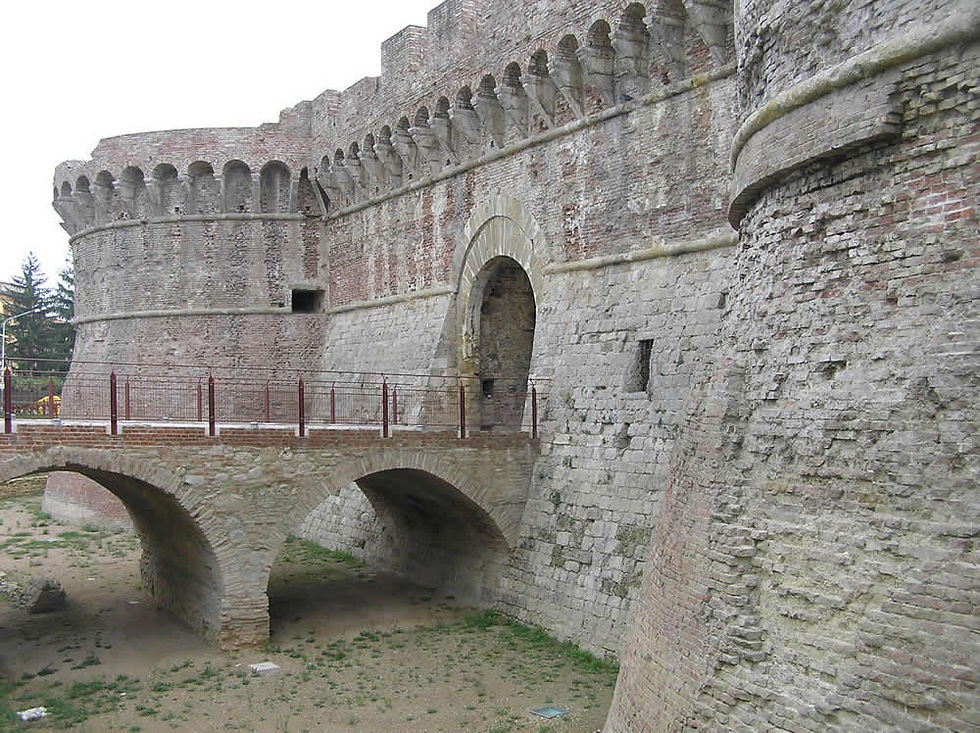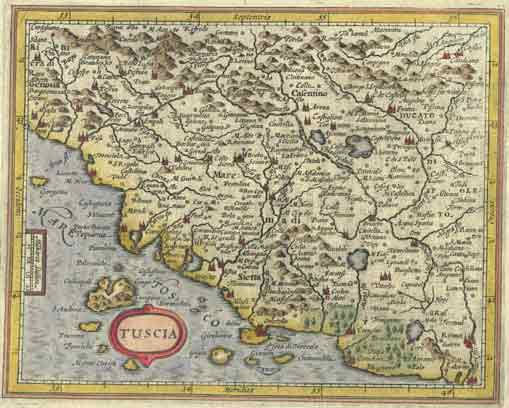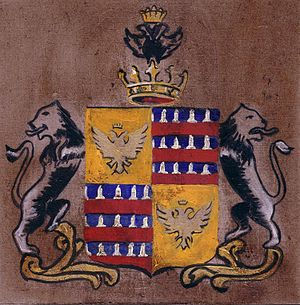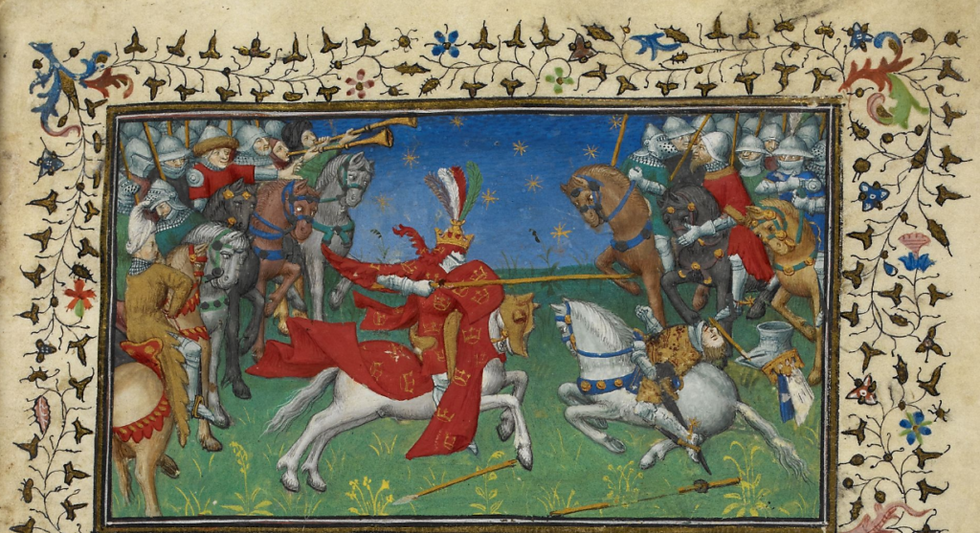The Italian Nobleman
Dominious Othuer di Gheraldini was a lord in Tuscany, Italy about 934 CE. Gammurini, the Italian historian records that
“the Gheraldi family were among the most ancient families of Tuscany in 900 A.D.” and he continues, “among the families of that name in Tuscany and Lombardy was the Marchese Gheraldi.”

A high ranking patrician named Gheraldo of the Gheraldini family had a son named Otto/Othuer [meaning one of wealth or nobility] Gerald is of German origin which suggests that they came with the barbarian tribes that swept into Italy in the 5th century. At that time the Romans were displaced by the Germanic tribes; the Lombardy took most of the coastal area around Rome including Tuscany while the Visigoths and Ostrogoths tribes settled in the northern region.

The family flourished until the political upheaval of 1125 which drove the patrician families into exile. The Gheraldini family renounced their patrician rank to become citizens. Later they were restored to their ancient honors and served the Republic of Florence in the senate and on the battlefield.

[Although the subject of the iconic painting entitled “Mona Lisa” by Leonardo De Vinci was a member of the Gheraldini family but the assertion that they shared an ancestry with the Grand Duke di Cosimos an influential supporter of the Renaissance in the 16th century was a fabrication by an Irish clergyman to impress his important patrons in England.]
Lord Gheraldini’s son Otho/ Othuer di Gheraldini was born abt. 1002 CE. and about 25 years old when a great celebration took place in Rome. All the heads of state, royalty and nobility of Europe were invited to the coronation of Conrad ll as the Holy Roman Emperor in 1027. Among the guests were the King Knute and Queen Emma of England feted by many of the Italian hierarchy.
Otho’s Long Journey in England began with Emma, Queen of England (1002-1043 CE.)


The Gheraldini family estate was in Val d'Elsa, Tuscany and it was feasible that the popular couple were invited to a lavish party at their castle. Some historians have surmised that this son of the Gheraldini joined the entourage of Queen Emma on her journey to Normandy to visit her family.

If the young Italian nobleman went to the Norman court he would have met the sons of the queen, Prince Alfred and Edward, in exile since 1016 with their uncle Duke Richard I and enjoyed the activities of a medieval male with that of hunting, jousting and joined the festivities at Falaise Castle, the seat of the Dukes of Normandy.
William II, 7th Duke of Normandy, the grandson of Richard I born in 1026 CE. would not have known the Italian nobleman but would have an impact on his son’s life.
There has been much speculation among historians regarding a marriage between the Italian nobleman and a Norman wife of a highborn status while he was a member of the duke’s court. While there exists no real proof of such an event, the chronicles of the time suggest that his descendants were half- Norman and the treatment of his son who later joined the court of Duke William II was indicative of the esteem for which the Gheraldini were accorded.
The date of the arrival of Otho/ Othuer in England is unknown, but it is significant to note that he was granted a great number of landholdings in southeastern England during the reign of King Knute (1016-1035). There were 26 lordships of Dominius Othuer di Gherardini in England before the reign of Edward 1042 CE. He established a townhome at Wallingford on the Thames River in the county of Berks [now Berkshire] between London and Winchester, where the Queen lived.
Lord Otho/Othuer’s son Walter, born in 1037, sent to Normandy about 1052 was mentored by Duke William and soon rose to be a member of his elite Royal Guard. While he attended the duke at his castle in Caen he was treated as a fellow Norman. In 1057 Walter FitzOthuer ( Fitz meaning ‘son’ in French) inherited his father’s estates in England which probably meant that Lord Othuer had died.

King Knute died in 1035 and his son Prince Harthacnute by Emma was the heir to the throne. But Harald, King Knute’s son by his first wife, acted as regent in the absence of Harthacanute who was also the King of Denmark detained in that country. With the political maneuvers that benefited the powerful Harold Godwin, Earl of Wessex, Harald of Denmark soon became accepted as the uncrowned King of England. This placed Queen Emma in a very uncomfortable position which also threatened her son, the legal heir, if he were to return to receive his crown.

A year later a letter was sent to Prince Edward and Alfred in Normandy which invited them to England to visit their mother. They accepted the invitation not suspecting it would prove to be a perilous journey. Prince Alfred was captured and murdered by Harald’s men but Prince Edward managed to escape to Normandy. Prince Edward, son of the Saxon King Athelred II, first husband of Queen Emma, acceded to the throne in 1042. Otho/ Othuer may have been involved in the safe journey of the prince for which he was rewarded.
According to an old lyric “the Earldom which to Otho brave, the Saxon sainted Edward gave” suggests that as King of England in 1042 he was granted valuable holdings for a valiant deed.
On the death of King Edward in 1066 Harold Godwinson, son of Earl Godwin, was chosen as his successor. Duke William of Normandy the cousin of Edward declared the throne was promised to him and launched a famous invasion to claim the throne the victorious duke was known as William the Conqueror, King William I of England (1066-1087). On the death of King Edward in 1066 Harold Godwinson, son of Earl Godwin, was chosen as his successor.
According to the records of the Domesday Survey, Sir Walter, a participant in the invasion and favorite of King William I received 22 estates in southeastern England. He maintained his father’s townhome in Wallingford an exclusive neighborhood where the Curia Regis, the king’s council resided. The Curia consisted of the Archbishop of Canterbury, the Bishop of Winchester, and the trusted companions of the conqueror at the invasion the Lords Hugh de Ferrers, Miles de Crispin and Walter Gifford. Some historians suggest that he may have been involved with the Curia as the Master of Arms.
In 1070, King William I began the building of Windsor Castle in Berks on the Thames, one of many strongholds he ordered each a day's ride from the other. Windsor, described as a “great pile of gray stones” kept the route open to London and the south coast hence to Normandy.
It is not surprising that Walter was made the castellan of Windsor, the constable or principal officer of a royal establishment. He held the important position of Warden of the Forests of Berks, a military position to guard against the king’s enemies. Both his appointments were inheritable and his descendants styled themselves as the Lords of Windsor until 1659. Originally a single tower built on an outcropping of stone it was enlarged over the centuries to include royal apartments, St. Georges Chapel, buildings for government activities and military operations.
Windsor Castle was such a favorite residence for the royal family that in 1917 King George V with a distinctly German surname of Saxe-Coburg adopted Windsor as a more politically acceptable surname during World War I. The castle remained a favorite of the late Queen Elizabeth II during her long reign.

Family Tree
Married: Beatrice abt. 1068 the daughter of Lord Offley, a Saxon knight. In the Chronicle of Adington a reference to Beatrice reads “Walter, son of Oter...and his wife Beatrice mother of William.” [The supposition that Lord Walter Fitzouether married a Welsh noblewoman, Gladys Rhillwalyn of Powys has been disputed by leading genealogists. Gladys was the mother-in-law of Walter’s son Gerald.] Children:
William Fitz Walter-born abt.1070.Succeeded his father in 1116 as Constable of Windsor and Keeper of the Forest, named as Lord of Eton by Henry I was the first to style himself as Lord of Windsor. Thomas 6th Baron Windsor died in 1641 thus ending the Windsor barony. His grandson, the Honorable Thomas Hickman Windsor was created Earl of Plymouth. Sir Ivor Edward Other Windsor-Clive is the present earl; his son the Honorable Robert Other Ivor Windsor-Clive, born in 1981 is the heir apparent. This family includes Other in the name of the first born son and heir in order to honor their ancestor Otho di Gheraldini, the Italian nobleman.
Gerald Fitz Walter-born aft.1070 appointed Constable of Pembrokeshire, Wales married Nest of Carru Castle daughter Rhys ap Tewdwr Mawr, Prince of South Wales and are the ancestor of the Carew families of England and Cornwall. Gerald’s descendants, the Fitzgeralds (sons of Gerald) were also the leaders of the Welsh-Norman invasion of Ireland in 1169 and given titles in the Peerage of England. Lord John Fitzgerald ascended to the title of Duke of Leinster in 1766 a great honor since this title had been reserved for royal family members by King William I. The Fitzgerald family continued as lords of Ireland until present.
Robert Fitz Walter of Windsor, Baron Eston-born aft. 1070.
Hugh Fitz Walter of Windsor-born aft.1070, Lord Horsely, Surrey.
Delicia, daughter-born aft.1070,married Lord William of Hastings.
Lord Otho/Othuer di Gherardini through his son Walter was the progenitor of the House of Windsor, the Carew of Beddington, England, Carew of Cornwall and the ancestors of the Fitzgerald, Fitzmaurice, Desmond and Keating families of Ireland. The descendants of Essex Beville born in 1640 in England the ancestor of the Beville family in the United States are descended from Otho Di Gheraldini through his great Grandfather Sir Nicholas Carew.
Compiled by Sandi B. Johnson, Historian
This document has been compiled by Sandra B. Johnson as an example of the interrelationships that merged the Anglo-Saxon and the Franco Norman Families. The Anglo Norman of England ARE the English of the present time.

Comments